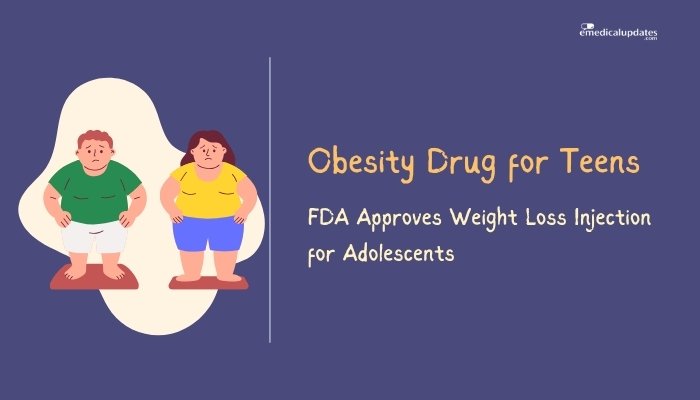Introduction
Childhood and teen obesity have reached alarming rates, posing significant health risks that can extend into adulthood—like diabetes, high blood pressure, and heart disease. While lifestyle changes remain the cornerstone of weight management, not all adolescents achieve meaningful or sustained results through diet and exercise alone.
Now, the U.S. Food and Drug Administration (FDA) has approved a new weight loss injection specifically for adolescents with obesity, potentially transforming how they manage their weight and long-term health outcomes.
Below, we examine how this injection works, what the clinical trials reveal, and what this development may mean for teenagers seeking safe, effective obesity treatment.
The Growing Challenge of Teen Obesity
Health Consequences
Excess weight in adolescence can lead to:
- Type 2 Diabetes: Rising insulin resistance sets in earlier.
- Cardiovascular Issues: Elevated blood pressure, lipid abnormalities.
- Emotional and Social Impact: Stigma and low self-esteem can harm mental health, hamper academic performance, and reduce overall quality of life.
Existing Approaches
Lifestyle interventions—nutrition education, counseling, structured exercise—remain foundational. Some teens also take part in bariatric surgery programs if they have severe obesity. However, many require additional medical therapies. Approved obesity drugs for youth have been quite limited until now.
The Newly Approved Injection
Mechanism of Action
The medication (often belonging to the GLP-1 receptor agonist class):
- Regulates Appetite: Mimics a hormone that signals fullness, leading to reduced hunger and calorie intake.
- Slows Gastric Emptying: Teenagers feel full longer after meals, aiding portion control.
- Aids Metabolic Health: Improves insulin sensitivity and sometimes lowers cholesterol or blood pressure.
Dosage and Administration
Teens typically self-inject the drug once weekly or as prescribed, rotating injection sites. Healthcare providers determine dosing based on the patient’s weight, overall health, and response.
Clinical Trial Results
Weight Reduction and Health Markers
In adolescent trials:
- Significant Weight Loss: Many participants experienced major reductions in Body Mass Index (BMI) compared to placebo, some achieving double-digit percentage drops.
- Improved Metabolic Factors: Reductions in triglycerides, blood pressure, or HbA1c were also observed.
- Quality of Life: Improved self-esteem and daily functioning, with fewer obesity-related complaints reported.
Safety Profile
Common side effects include:
- Gastrointestinal Issues: Nausea, diarrhea, or constipation as the body adjusts.
- Potential Gallbladder Concerns: Rapid weight loss can increase gallstone risk.
- Monitoring: Teens on the injection must regularly meet with their pediatricians or endocrinologists for dose adjustments, nutritional advice, and to address side effects.
Who Qualifies?
- Teens with Obesity: Typically defined as a BMI ≥95th percentile for age and sex. Some guidelines also factor in comorbidities.
- Failed Conventional Measures: Those who haven’t achieved sufficient weight loss through dieting, exercise, or counseling alone.
- No Underlying Conditions that would contraindicate use—like certain endocrine disorders or severe GI diseases. Careful screening is essential.
Benefits and Considerations
Potential Advantages
- Substantial Weight Loss: Potentially bridging the gap for teens who can’t meet goals with lifestyle modifications alone.
- Reduced Comorbidities: Mitigating or preventing conditions like type 2 diabetes early might stave off adult complications.
- Improved Psychosocial Well-Being: Feeling in control over weight can lift confidence and social engagement.
Remaining Questions
- Long-Term Safety: These are relatively new medications; extended data in adolescents are still accruing.
- Cost and Coverage: Insurance reimbursement for obesity drugs can be inconsistent, and out-of-pocket expenses may pose barriers.
- Sustainability: Maintaining weight loss after stopping medication needs further clarity, ensuring teens won’t simply revert once therapy ends.
Future Outlook
Comprehensive Treatment
Although powerful, medication alone typically isn’t enough. Ongoing success often demands:
- Nutritional Counseling: Balanced diets and portion guidance.
- Physical Activity: Encouraging consistent exercise routines.
- Behavioral Health Support: Addressing emotional eating triggers and mental health issues.
Expanding Pediatric Obesity Management
If results remain positive, more advanced therapies targeting other metabolic pathways might follow. The acceptance of anti-obesity medication for teens could broaden, normalizing medical interventions for what is increasingly recognized as a chronic disease rather than a mere lifestyle choice.
Pediatric Obesity Prevention
Simultaneously, experts stress that prevention—through public health policies, better food environments, and early interventions—remains critical. These new medications are one piece of a multifaceted approach.
Frequently Asked Questions
- Are weight loss injections safe for all teens?
- Only for those with obesity meeting specific criteria. Physicians must evaluate each patient’s health status and potential drug interactions.
- How quickly do teens lose weight on the injection?
- Results vary, but many see meaningful BMI reduction within the first few months, continuing as treatment proceeds.
- Will they need to take it indefinitely?
- Long-term use may be required to maintain benefits, though some might transition off after significant lifestyle changes. More data is needed on post-cessation weight trends.
- Do lifestyle changes still matter with the injection?
- Absolutely. Dietary habits and exercise remain foundational, improving and sustaining medication benefits.
- Are there side effects beyond GI upset?
- Some may experience headaches, fatigue, or mild injection-site reactions. Serious events are rare but possible, emphasizing routine follow-up.
Conclusion
The FDA’s approval of a new weight loss injection for adolescents signals a shift in obesity treatment, acknowledging that many teens struggle to shed excess weight through conventional methods alone. By combining powerful appetite regulation and metabolic benefits, this medication can spur significant improvements in BMI, health markers, and overall quality of life. Still, success hinges on a holistic approach—teens must adopt balanced diets, consistent activity, and routine check-ins with healthcare professionals. As the medical community continues to refine usage guidelines and gather long-term safety data, this injection could become a cornerstone for tackling the teen obesity epidemic, offering hope for healthier futures.



